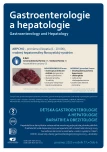Hepatobiliary complications in autosomal recessive polycystic kidney disease
Authors:
M. Brndiarová 1; N. Haláčová 1; M. Kozár 2; Michal Demeter 3; M. Schnierer 3; Z. Havlíčeková 1
Authors‘ workplace:
Klinika detí a dorastu JLF UK a UN Martin
1; Neonatologická klinika JLF UK a UN Martin
2; Interná klinika – gastroenterologická JLF UK a UN Martin
3
Published in:
Gastroent Hepatol 2023; 77(6): 495-501
Category:
doi:
https://doi.org/10.48095/ccgh2023495
Overview
Introduction: Autosomal recessive polycystic kidney disease (ARPKD) is a rare, phenotypically variable primary ciliopathy. Kidney and liver damage are typical manifestations, and the prognosis of the disease depends on their progression over time. The main extrarenal manifestation is fibrocystic rebuilding of the liver, which is manifested by intrahepatic portal hypertension and cholangitis. Methods: The aim of the retrospective study was to evaluate the incidence and development hepatobiliary manifestations. Results: Eight children with polycystic autosomal recessive kidney disease were included in the group. Renal damage and hypertension were present in all children. Hepatobiliary manifestations were described in five children (62.5%). Thrombocytopenia preceded splenomegaly by one year. The results also include three case reports. Conclusion: Patients with ARPKD should be examined with a focus on the presence of hepatic manifestations of the disease.
Keywords:
osomal recessive polycystic kidney disease – esophageal varices – fibrocystic disorder – thrombocytopenia
Sources
Literatúra
1. Gimpel C, Avni FE, Bergmann C et al. Perinatal diagnosis, management, and follow-up of cystic renal diseases: A clinical practice recommendation with systematic literature reviews. JAMA Pediatr 2018; 172 (1): 74–86. doi: 10.1001/jamapediatrics.2017.3938.
2. Dorval G, Boyer O, Couderc A et al. Long-term kidney and liver outcome in 50 children with autosomal recessive polycystic kidney disease. Pediatr Nephrol 2021; 36 (5): 1165–1173. doi: 10.1007/s00467-020-04808-9.
3. Srinath A, Shneider BL. Congenital hepatic fibrosis and autosomal recessive polycystic kidney disease. J Pediatr Gastroenterol Nutr 2012; 54 (5): 580–587. doi: 10.1097/MPG.0b013e31824711b7.
4. Liebau MC. Early clinical management of autosomal recessive polycystic kidney disease. Pediatr Nephrol 2021; 36 (11): 3561–3570. doi: 10.1007/s00467-021-04970-8.
5. Turkbey B, Ocak I, Daryanani K et al. Autosomal recessive polycystic kidney disease and congenital hepatic fibrosis (ARPKD/CHF). Pediatr Radiol 2009; 39 (2): 100–111. doi: 10.1007/s00247-008-1064-x.
6. Gunay-Aygun M, Font-Montgomery E, Lukose L et al. Characteristics of congenital hepatic fibrosis in a large cohort of patients with autosomal recessive polycystic kidney disease. Gastroenterology 2013; 144 (1): 112–121. doi: 10.1053/j.gastro.2012.09.056.
7. Wehrman A, Kriegermeier A, Wen J. Diagnosis and Management of Hepatobiliary Complications in Autosomal Recessive Polycystic Kidney Disease. Front Pediatr 2017; 5: 124. doi: 10.3389/fped.2017.00124.
8. Burgmaier K, Kilian S, Bammens B et al. Clinical courses and complications of young adults with Autosomal Recessive Polycystic Kidney Disease (ARPKD). Sci Rep 2019; 9 (1): 7919. doi: 10.1038/s41598-019-43488-w.
9. Majeed AN, Font-Montgomery E, Lukose L et al. Prospective Evaluation of Kidney and Liver disease in Autosomal Recessive Polycystic Kidney Disease-Congenital Hepatic Fibrosis. Mol Genet Metab 2020; 131 (1–2): 267–276. doi: 10.1016/ j.ymgme.2020.08.006.
10. Ros E, Navarro S, Bru C et al. Ursodeoxycholic acid treatment of primary hepatolithiasis in Caroli’s syndrome. Lancet 1993; 342 (88 68): 404–406. doi: 10.1016/0140-6736 (93) 928 17-D.
11. D’Onofrio M, Crosara S, De Robertis R et al. Contrast-Enhanced Ultrasound of Focal Liver Lesions. AJR Am J Roentgenol 2015; 205 (1): 56–66. doi: 10.2214/AJR.14.14203.
12. Kishina M, Koda M, Tokunaga S et al. Usefulness of contrast-enhanced ultrasound with Sonazoid for evaluating liver abscess in comparison with conventional B-mode ultrasound. Hepatol Res 2015; 45 (3): 337–342. doi: 10.1111/hepr.12347.
13. Michnová Z, Pršo M, Zúbriková L et. al. Diagnostika ložiskových lézí jater u dětí s využitím kontrastní ultrasonografie. Gastroent Hepatol 2019; 73 (6): 481–487. doi: 10.14735/ amgh2019481.
14. Ko JS, Yi NJ, Suh KS et al. Pediatric liver transplantation for fibropolycystic liver disease. Pediatr Transplant 2012; 16 (2): 195–200. doi: 10.1111/j.1399-3046.2012.01661.x.
15. Mekahli D, van Stralen KJ, Bonthuis M et al. ESPN/ERA-EDTA Registry Kidney versus combined kidney and liver transplantation in young people with autosomal recessive polycystic kidney disease: data from the European Society for Pediatric Nephrology/European Renal Association-European Dialysis and Transplant (ESPN/ERAEDTA) Registry. Am J Kidney Dis 2016; 68: 782–788. doi: 10.1053/j.ajkd.2016.06.019.
16. Millwala F, Segev DL, Thuluvath PJ. Caroli’s disease and outcomes after liver transplantation. Liver Transpl 2008; 4 (1): 11–7. doi: 10.1002/lt.21366.
17. Wen J, Furth SL, Ruebner R. Kidney and liver transplantation in children with fibrocystic liver-kidney disease: data from the US scientific registry of transplant recipients: 1990–2010. Pediatr Transplant 2014; 18: 726–732. doi: 10.1111/petr.12330.
Labels
Paediatric gastroenterology Gastroenterology and hepatology SurgeryArticle was published in
Gastroenterology and Hepatology

2023 Issue 6
Most read in this issue
- Pancreatic cancer surveillance in high-risk individuals Position statement of professional societies
- Practical clinical recommendations for perioperative care in bariatric surgery 2023: adaptation of ERAS (Enhanced Recovery After Surgery) recommendations with consensual voting of working group of Joint Section of Bariatric and Metabolic Surgery of Czech Surgery Society and Czech Obesitology Society
- Hepatobiliary complications in autosomal recessive polycystic kidney disease
- Report from the 37th Slovak and Czech Congress of Gastroenterology
